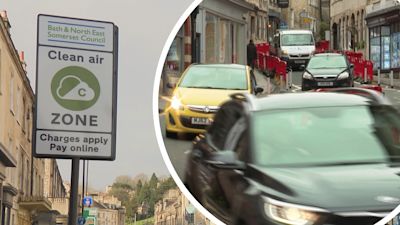Air pollution drops in Bath Clean Air Zone - but areas of concern remain

A new report shows the impact which Bath's Clean Air Zone (CAZ) is having on the city's air pollution levels.
The data shows an average 14 per cent decrease in nitrogen dioxide (NO2) levels within the CAZ in the past quarter compared with the same period in 2019, with similar levels shown in urban areas outside the zone’s boundary.
However, Bath and North East Somerset (BANES) Council says there is still work to do, with NO2 levels increasing in four areas - which is thought to be due to roadworks including the Cleveland Bridge renovation project.
The figures have been published as part of the second quarterly report to monitor the performance of the CAZ, which is going before the council cabinet on December 16. It analyses air quality and traffic data gathered for the period July to September 2021, compared to the same months in 2020.
Air quality has improved at key locations including Gay Street and Upper Bristol Road.
The council says the data also indicates the CAZ is having the intended effect of improving fleet compliance and changing behaviours.
More than 90% of HGVs, coaches, buses and taxis entering the zone are now compliant. Van compliance rates have also seen an upturn and are now approaching 80%.
The report also states that of the 2,500 vehicles assessed under the council’s financial assistance scheme to replace non-compliant polluting vehicles, 1,495 were found to be eligible. 591 vehicles have already been replaced with hundreds more expected to be upgraded in the coming months.
Levels of NO2 at Wells Road, Victoria Buildings, Broad Street, and Chapel Row have increased but the council believe this will stabilise once temporary roadworks are finished.
Councillor Sarah Warren, Deputy Leader and cabinet member for Climate and Sustainable Travel, said: “Once again, this quarterly update provides encouraging data that air quality is improving and pollution is reducing in the city.
"We have updated the method by which we make some of the comparisons with the results from previous quarters, making these figures even more robust. It’s fantastic news that the CAZ is having the intended effect of tackling the air pollution that can significantly damage people’s health.
“However, the impact of temporary works in the city on traffic flow - including Cleveland Bridge – mean that we cannot draw firm conclusions on data for the locations showing an increase in NO2.
"We need to take a long-term view as we expect to see an improvement in air quality in these areas in the coming months, which we’ll draw further conclusions about in forthcoming reports.
Residents tell ITV they think the CAZ has pushed traffic into other areas. The council will continue to monitor the situation.
“Our target is to reduce annual average concentrations of NO2 to below 40 μg/m3 (micrograms per cubic meter of air) at every location where we measure NO2 in Bath, as soon as possible and by the end of 2021 at the latest.
"Obviously, we will not know whether we’ve achieved this until our annual report released in the spring of next year. Our quarterly reports suggest that there are still a few areas that are a cause for concern, including around Cleveland Place, so we ask that everyone pulls together to limit their use of vehicles where viable alternatives exist, such as using park and rides, walking, using an electric bike or scooter or car sharing.”
“We are also working with the Joint Air Quality Unit (JAQU) on how we demonstrate that we have achieved compliance with air quality limits going forward.”
How does the Bath CAZ work?
Bath's CAZ was launched on 15 March 2021 to tackle harmful levels of air pollution caused by the most polluting taxis, vans, buses and larger commercial vehicles regularly driving in the city.
It was the first clean air zone to be launched outside London and it levies a £9 or £100 a day charge on anyone driving a chargeable higher emission vehicle in the zone. This excludes private cars and motorcycles which are not charged.
The charges are designed to deter higher polluting vehicles from entering the zone, while also speeding up the natural replacement rate of polluting vehicles in exchange for cleaner ones. Any revenue over and above the operating cost will be spent on providing sustainable transport.
You can read the full report going before cabinet on December here.